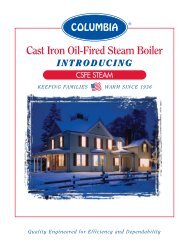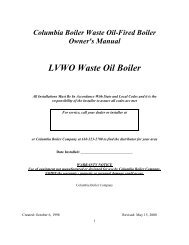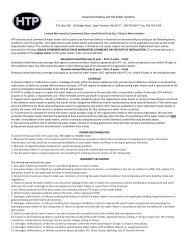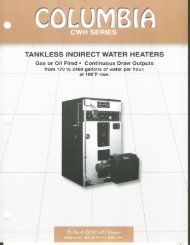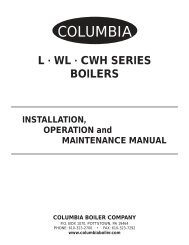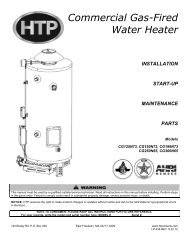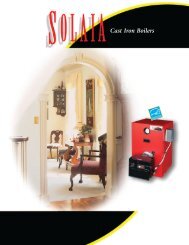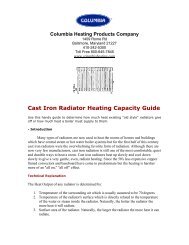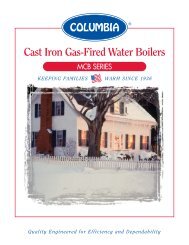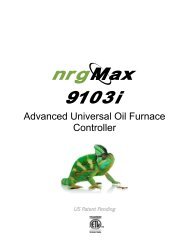MPH Manual - Columbia Heating
MPH Manual - Columbia Heating
MPH Manual - Columbia Heating
You also want an ePaper? Increase the reach of your titles
YUMPU automatically turns print PDFs into web optimized ePapers that Google loves.
Fuel line installation: Consult the burner section of this manual for oil line type and sizing<br />
requirements for proper operation. The size of oil lines is extremely important for proper operation.<br />
Continuous lengths of heavy wall copper tubing are recommended and should be installed<br />
under the floor whenever possible. Fuel lines should not chaff the appliance or building structure.<br />
All oil feed lines must be air tight. Use as few fittings as possible when assembling the oil lines.<br />
Compression fittings allow more of a chance for air to be introduced into the oil supply and are<br />
NOT recommended for use. The slightest air leak, usually caused by loose fittings or bad gaskets,<br />
can cause poor starts, smoky starts, sooting of burner parts, inefficient operation, and a<br />
dangerous combustion condition. Always install fittings in accessible locations.<br />
WARNING:<br />
TEFLON ® TAPE SHOULD NEVER BE USED WITH ANY OIL LINE CONNECTIONS. THE<br />
USE OF TEFLON ® TAPE ON BURNER COMPONENTS OR OIL SERVICE LINES WILL<br />
VOID MOST BURNER WARRANTIES.<br />
A vacuum test should be done on all installations to ensure that all fittings are tight and the oil<br />
lines are of proper size. Suction vacuums must be held to acceptable limits. This is available<br />
with the pump information supplied with the burner.<br />
Fuel line valve and filter: (Not supplied) Install two high quality shutoff valves in accessible<br />
locations on the oil supply line. Locate one close to the tank and the other close to the burner<br />
ahead of the filter. Some filters come with built-in shutoff valves. Install a generous capacity filter<br />
inside the building between the fuel tank shutoff and burner.<br />
For additional information consult the burner section of this manual.<br />
GAS SUPPLY PIPING<br />
Contact your local gas company to ensure that adequate gas service is available, and to review<br />
applicable installation codes for your area.<br />
The minimum gas supply pressure required by the burner is seven inches water column for all<br />
Power Flame <strong>MPH</strong> Series burners. The maximum gas supply pressure to the Power Flame<br />
burner is fourteen inches water column. Gas pressure greater than fourteen inches water column<br />
will require an additional gas pressure regulator to prevent damage to the primary gas regulator.<br />
Gas pressure below the minimum will cause combustion efficiency problems and should<br />
be avoided if possible. Low gas pressure may also prevent the boiler from obtaining the desired<br />
input rate, which will cause the boiler to be unable to produce the desired output. Consult the<br />
factory if your gas supply pressure is not in the recommended range, or for pressure requirements<br />
for other burner manufacturers.<br />
Use the following tables to determine the size of the main gas line required for the boiler that is<br />
being installed. First determine the required input volume of gas needed at the gas manifold,<br />
then determine the correct pipe size for the length of run needed.<br />
<strong>MPH</strong> COLUMBIA BOILER COMPANY 10



